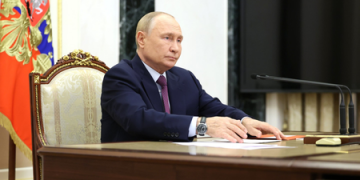China is building infrastructure along the border with India – a second bridge in an area held by it around the strategically key Pangong Tso lake in eastern Ladakh which it occupied in 2020 during the pandemic. The Indian Ministry of External Affairs (MEA) has, in an official statement, said that it is closely ‘monitoring’ the development. Some may find MEA’s communiqué to be kind of funny. The Union government has been constantly bashing past Congress led governments for supposedly giving up vast tracts of Indian territory to the Chinese since the 1960s. Today, the BJP led government admittedly stands as a mute spectator to the developmental activities being taken up by China on recently annexed Indian territory.
There have been 15 rounds of diplomatic and military talks between India and China which have, as yet, yielded no results. No one is aware of who the negotiators from the Indian side are nor does anyone care what arguments or historical proofs are being put forth by the bureaucracy of New Delhi. The new construction is expected to help the Chinese military quickly mobilise its troops in the region. China has also been establishing other infrastructure such as roads and residential buildings in the border areas with India. It probably aims to populate that high altitude terrain with Han Chinese so that the rear of the military will be safe during operations.
Unfortunately, it took a US general to inform the Indian public about the fresh Chinese build-up which he called an “eye-opener” and “alarming.” It is very possible that Indian intelligence had known all along about these Chinese activities but preferred to keep the public in the dark. The reason, most likely, could be that they did not want to expose their own failings. Unfortunately the Americans exposed the Indian government through their public declaration. The US Pacific Area Commanding General Charles A Flynn termed China’s build-up near Ladakh and strengthening of its military infrastructure as part of Beijing’s “corrosive and destabilising behaviour.” The General has been part of the Pacific Command since 2014 under various ranks and his assessment does carry weight.
The Government of India owes an explanation to the people of this country as to why it is keeping quiet and not registering protest publicly nor raising the issue with the Chinese authorities, both bilaterally and at international forums. The moot point is the behaviour and the manner in which China is acting should be a matter of great concern for India and other countries as well.
A day after the US General articulated his views of the situation, an MEA spokesperson indulged in diplomatic obfuscation. He merely said the government “carefully monitors developments along our border areas, including construction of infrastructure by the Chinese side in the Western Sector, as well as that being undertaken further in-depth areas.” While the government, according to the spokesperson was “committed to, and takes all adequate and appropriate measures to safeguard territorial integrity and sovereignty,” he forgot to mention what are the tangible measures that the government has taken to safeguard territorial integrity. This means China can get away with doing whatever it likes, treating the border talks in a cavalier manner and India would only dance to its tune.
China, of course, sought to discredit the US General for spilling the beans about its build-up. Its foreign affairs spokesman said that the US was playing a dangerous game by commenting on matters that India and China are trying to resolve through negotiations. It is only natural that China would not brook any adverse reactions from the US when it can continue playing its own game without any protests from India.







































